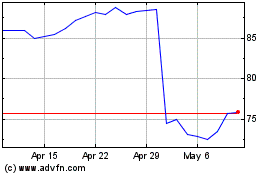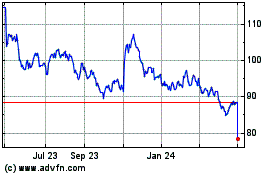Global Logistic Properties to Buy U.S. Warehouse Portfolio for $1.1 Billion
September 12 2016 - 9:00PM
Dow Jones News
Global Logistic Properties Ltd. said it has agreed to buy
distribution centers from Hillwood Development Co. for $1.1
billion.
GLP, a large industrial property company part-owned by
Singapore's sovereign-wealth fund, has been aggressively expanding
in the U.S. over the last two years, as the rise of online shopping
drives up the values of distribution centers.
The Hillwood portfolio, with 15 million square feet, solidifies
GLP's position as the second-largest owner of warehouses in the
U.S., after San Francisco-based real-estate investment trust
Prologis Inc. Upon completion of the deal, GLP will own nearly 200
million square feet of warehouse property in the U.S., compared
with about 325 million for Prologis.
Hillwood, which is controlled by Ross Perot Jr., a Dallas-based
property investor and son of the former U.S. presidential
candidate, is selling properties in Ohio, Pennsylvania, Dallas,
Atlanta, Los Angeles and Chicago.
The largest tenants in the portfolio are Amazon.com Inc.,
Starbucks Corp., NFI, Williams-Sonoma Inc. and Wayfair Inc.
Charles Sullivan, GLP's chief operating officer, said the
purchase reflects the rising importance of online shopping, which
has shortened delivery times for consumer products and forced
retailers to offer more shipping options to customers.
"There was a time when warehousing and distribution was just
another part of the supply chain," Mr. Sullivan said.
"Logistics…has moved up in its importance in corporate strategy.
The customer is more a part of the distribution than they were 10
or 15 years ago."
Deal-making in the real-estate sector has slowed from its record
pace last year. Investors bought nearly $78 billion worth of
warehouses and distribution centers in 2015, according to data firm
Real Capital Analytics. Through July of this year, however, only
$29.2 billion worth of industrial property had changed hands, Real
Capital said.
GLP has been one of the market's biggest buyers in recent years,
including its $4.6 billion purchase of 200 U.S. warehouses from
Industrial Income Trust in 2015 and its $8.1 billion purchase of
IndCor Properties, a large portfolio owned by Blackstone Group LP
in late 2014. Most of the company's properties are in Asia.
In April of last year, Prologis announced its $5.9 billion
purchase of KTR Capital Partners, another large warehouse
owner.
Analysts say the rush for property in 2015 was the result of
investors looking for alternatives to low bond-market yields amid a
surfeit of large industrial property portfolios arranged during the
real-estate downturn that followed the financial crisis of 2008 and
2009. After a spate of blockbuster deals, there are fewer large
portfolios for sale.
Last year was "the busiest year in history in terms of pure
acquisitions," said Eric Frankel, an analyst with Green Street
Advisors. "The challenge to industrial real estate is that it's a
low cost-per-square-foot business, and it takes a lot of time to
assemble a big enough portfolio to interest large institutional
investors. You are seeing a lot of smaller portfolios out
there."
Like many real-estate firms, GLP raises funds from large
institutional investors, then uses a mix of those funds and debt to
buy and manage properties, while keeping a small equity stake for
themselves. For most of its U.S. deals, GLP retains around a 10%
stake in the properties after it buys them.
The latest GLP deal is expected to close in two rounds:
acquisition of about two-thirds of the property will be completed
in December, while the remainder will close in the next 18 to 24
months. The warehouses in the first round of closings are 100%
leased, while the second round of closings is contingent on a full
lease-up the properties.
Write to Robbie Whelan at robbie.whelan@wsj.com
(END) Dow Jones Newswires
September 12, 2016 20:45 ET (00:45 GMT)
Copyright (c) 2016 Dow Jones & Company, Inc.
Starbucks (NASDAQ:SBUX)
Historical Stock Chart
From Mar 2024 to Apr 2024

Starbucks (NASDAQ:SBUX)
Historical Stock Chart
From Apr 2023 to Apr 2024
